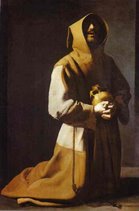 One of the challenges in studying learning and behavior is uncovering the neurobiological mechanisms that separate goal-oriented behaviors into those that provide a primary reinforcer (by satisfying a basic drive, such as the one for food or sex) and those that provide some as-yet-unknown experience linked to a primary reinforcer (cues). For example, an animal that has learned to associate food with a tone will work for the tone, even if no food (the primary reinforcer) is provided.
One of the challenges in studying learning and behavior is uncovering the neurobiological mechanisms that separate goal-oriented behaviors into those that provide a primary reinforcer (by satisfying a basic drive, such as the one for food or sex) and those that provide some as-yet-unknown experience linked to a primary reinforcer (cues). For example, an animal that has learned to associate food with a tone will work for the tone, even if no food (the primary reinforcer) is provided.The ability of these cues to drive behaviors is not fully understood, although cues play a large role in the maintenance of many behaviors, including maladaptive ones such as addiction. How do we learn to work for money (and that the cue - money - will help us satisfy our more basic drives), or in the case of negative reinforcement, why does a yellow light turning red as we drive through it strike a tad bit of fear in us? These situations involve a complex series of associations that are in part linked to our biological survival.
The following sections from a recent Nature article summarize some new findings.
From John Whitfield’s article “The Essence of Happiness” in Nature.
Burke, K. A. , Franz, T. M. , Miller, D. N. & Schoenbaum, G. Nature advance online publication, doi:10.1038/nature06993 (18 June 2008).
Separating the cognitive (goal-oriented) and general (emotional) systems is difficult, because achieving your goal makes you feel happy. Schoenbaum and his colleagues achieved it by using an ingenious variation on classical pavlovian conditioning.
First, the researchers taught rats to associate one light with a grape-flavoured sucrose pellet, and a different light with a banana-flavoured pellet. Such conditioning makes the lights gratifying on their own — animals will work to experience the cue, even if they don't get a pellet.
Then, the team played sounds along with the lights. The 'grape' light with a sound still delivered a grape pellet. In this situation, animals tend to ignore the extra information and do not learn to associate the sound with food.
But the 'banana' light plus a sound led to a different reward – a grape-flavoured pellet. So in this case, the sound adds information. The light means something nice is coming and the sound tells you what flavour it will be.
Rats like the two flavours equally, so the sound says nothing about the treat's value, only its details.
The team next tested the rats on sounds and lights alone. The animals, they found, will press a bar to obtain either the light or the sound on its own, even if no food pellet follows on. The generalized reward of the treat and the abstract property of its flavour were equally strong motivations.
But rats with damage to an area of their brain called the orbitofrontal cortex, which is thought to be involved in decision-making, would work to see the treat-associated light, but not to hear the grape-associated sound. That is, they will work for a cue associated with positive emotions, but not one linked only to a specific outcome.
It's a bit like separating Homer Simpson's "Mmm… donuts", into a generalized expression of pleasure ("Mmm"), and the specific object of his desire (the "donuts"), and working out the brain regions responsible for each thought.
Schoenbaum suggests that the orbitofrontal cortex, which lies at the front of the brain, just above the eyes, is the home of the brain's cognitive reward system. It acts as a forecaster, predicting the value of different behaviours, learns which ones are ultimately rewarding, and triggers a corresponding emotional response.
Normally the two systems will give the same 'answer'. But the orbitofrontal cortex could also act as a kind of policeman, says Schoenbaum, diverting the pursuit of immediate gratification in favour of longer-term goals.
(The picture of fries is a cue, although I don't think it's sufficiently satisfying.)

